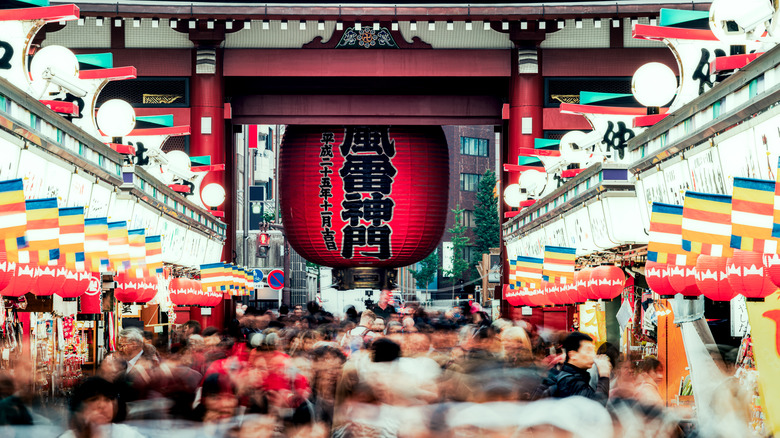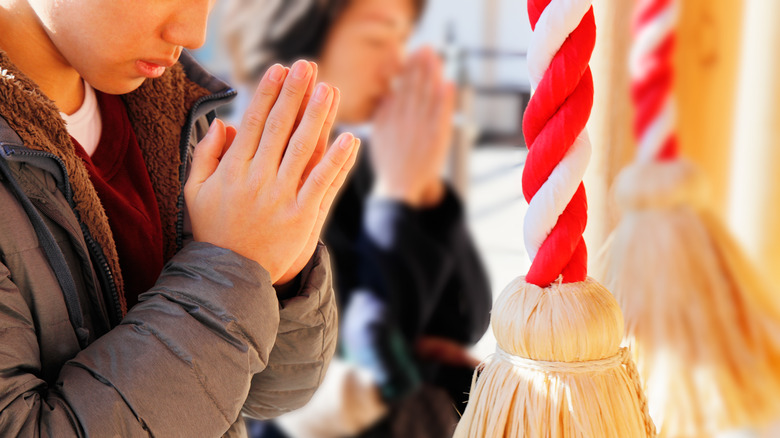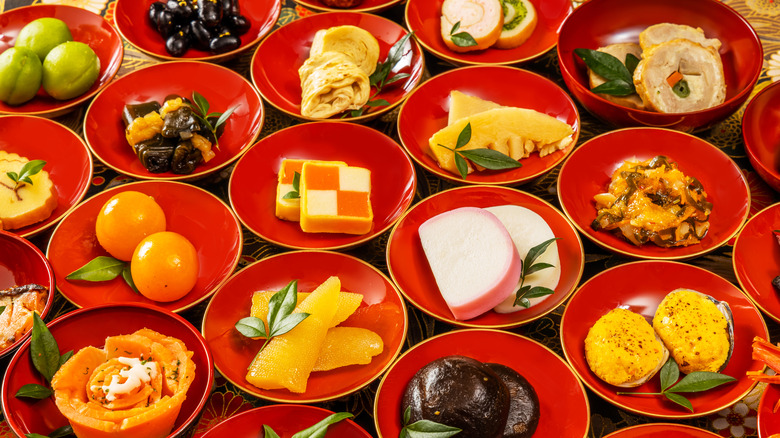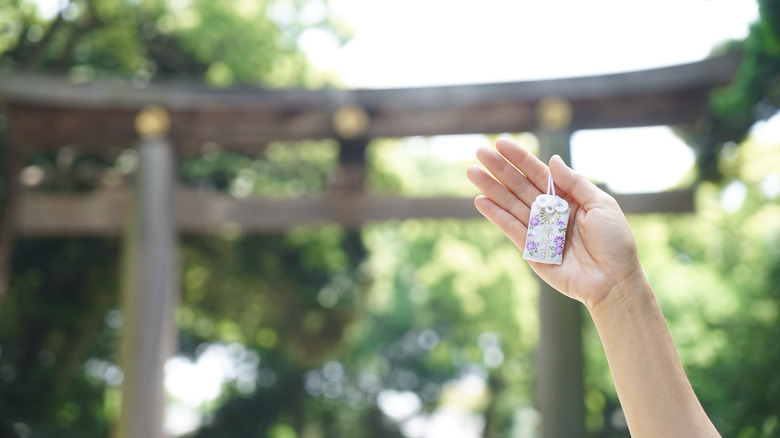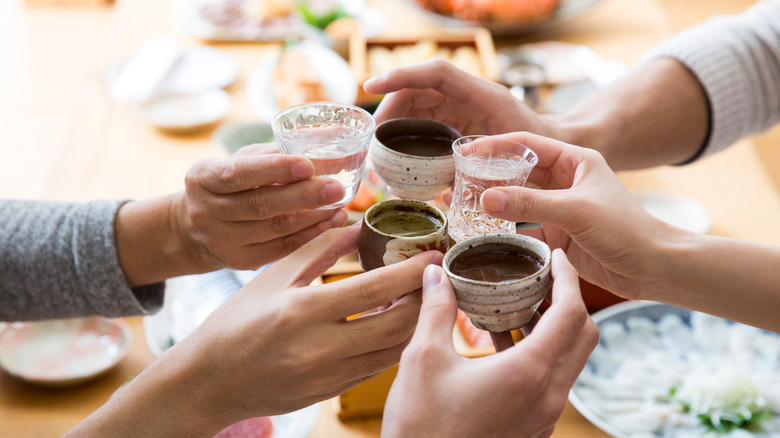How Do They Celebrate New Year's In Japan?
Japan is a nation that's captivated the imagination of the West for decades, and a lot of it has to do with seeming contradictions. In Japan, romanticized, feudal warlords and a legacy of brutal samurai meet modern, kewpie-cute "kawaii" culture and Harajuku "Lolita" cosplay. Ancient, nature-oriented Shinto traditions meet gonzo neon karaoke nights in perpetually lit downtown Tokyo. The pared-down aesthetics of highly ritualized, formal arts like tea ceremony and traditional poetry meet the explosively noisy ruckus of bright, loud, combat-driven anime.
All of these seeming contradictions are held together by very particular, unbroken cultural threads: family bonds, social obligations, and the importance of proceduralism. These threads all ravel together at New Year's. Unlike neighboring China (Chinese New Year's is at the beginning of February), Japan celebrates New Year's Eve and Day according to the Western calendar. But unlike the West, New Year's in Japan isn't a time for uproarious partying and regretful hangovers. These things exist, but they're either for expats or the defiantly countercultural. In general, New Year's is a time of quiet reflection, spiritual renewal, structured activities, and blood relations over friends. And for the record, Christmas is the opposite: friends and parties rather than homey family time.
There are loads of New Year's traditions in Japan, many of which are covered on websites like Tokyo Cheapo and Savvy Tokyo. It would get tedious to discuss everything, and details change from region to region besides. This article will cover some basic, broad swaths shared across the whole country.
Praying at shrines and temples
Much like Japanese society on a whole, New Year's in Japan has one leg in Shinto, the other in Buddhism. Shinto is Japan's original, ancient, native belief system. We're not talking a "religion" in the way folks in the West think of a formalized doctrine with sacred tomes. Rather, as the Meiji Jingu shrine website briefly summarizes, Shinto resembles other, worldwide indigenous beliefs by emphasizing a respect of nature and its spirits ("kami").
Buddhism arrived in Japan in the 12th century by way of Korea, as the BBC explains, where it arrived from China 500 years earlier in the seventh century. By that time, it had already accumulated elements of Chinese cultural Taoism and Confucianism, which carried over into Japan. In Japan, Buddhism got culturally adjusted again — because of Shinto — into what's called "Zen" Buddhism, an often austere discipline of self-control.
In Japan, folks visit shrines (for Shinto) and temples (for Buddhism) on a regular basis; they're everywhere in cities and the countryside. It's particularly important to pay a visit on New Year's, though, and pray to the gods for prosperity, health, what have you — a visit called "hatsumode," per HIS Go. Most Japanese people don't make a distinction between which gods and where, except for specific, well-known locations like the shrine on Mt. Tsukuba in Ibaraki prefecture, dedicated to love and romantic relationships, as Voyapon outlines. Monks also ring bells at midnight on New Years to (literally) ring in the new year.
Eating symbolic food
Before heading out to shrines and temples for the year's first visit, "hatsumode," there's food. Japan has an exceptionally intricate and vast food-based heritage that goes way, way beyond sushi and miso soup. And for the record, California rolls don't come from Japan. Shocking, we know (hint: it's in the name).
Without a doubt, the key component to New Year's food in Japan is "osechi," a kind of combo platter of a bunch of different, small food items, each with a different symbolic value. It's typically homemade, varies from region to region, and is eaten together with family at some point over the first few days of the new year. As Savvy Tokyo overviews, herring roe, for instance, represents fertility, and chestnuts represent wealth. Tsunagu Japan continues by explaining that tiny omelets represent education and knowledge, black beans represent health, and salmon rolls wrapped in kelp represent the energy of youth. The list goes on and on.
Folks eat other, traditional food on New Year's Eve. Soba is a popular choice: dense, buckwheat noodles dipped in a robust broth called "mentsuyu" made from a host of typical kitchen items: sake, soy sauce, mirin (sweet cooking wine), etc. Toppings vary, but include things like tiny shrimp, whose curved back symbolizes a long life. Japanese clementines ("mikan") are often on the menu, too, as well as "ozoni" on New Year's morning: mochi stirred into a rich, brothy soup. The latter is a favorite among kids.
Receiving good luck and binding bad luck
In the vein of praying for luck, prosperity, health, etc., some folks in Japan also follow a bunch of small traditions that have somewhat waned in recent decades.
Nengajo are at the top of this list. As Tokyo Cheapo summarizes, these are postcards specifically manufactured for New Years, which people send out en masse to relatives, friends, acquaintances, long-lost twins, the dude who fixed your car in June, practically anyone who you want to thank from the year. Because we live in a digital age, lots of people have stopped writing these by hand and started sending out digital versions.
In similar "maintain the circle of gratitude and fortune" fashion, older people often pass along money to grandchildren or the youths in their lives. These gifts, called "otoshidama," are traditionally tucked into specific, money-giving envelopes called "pochibukuro" ("tiny bag"). Such envelops, per HIS Go, can be decorated with calligraphy, artwork, or the same symbolism associated with New Year's good luck charms ("omamori") that folks keep on their person as a kind of wish, as Savvy Tokyo outlines. To keep away bad mojo, people sometimes tie a piece of white paper ("omikuji") to wooden posts at shrines or temples to bind various evils to a holy spot, as Savvy Tokyo also describes.
Finally, people sometimes decorate the entrances to their houses with similar good luck objects, such as potted ornaments made from bamboo and pine and plum trees, per Japan Guide.
Cleaning and end-of-the-year parties
If it wasn't already clear, New Year's in Japan is a time of renewal and rejuvenation. It's a chance to shed hang-ups and focus on a fresh, upcoming year.
To that end, Japanese households often engage in a super deep cleaning leading up to New Year's, as Savvy Tokyo overviews. This is similar to "spring-cleaning" in the U.S., for instance, and focuses on parts of the house often overlooked during the rest of the year. Dirty window screens are a good example, or the furthest recesses of junk-ridden closets. New Year's Day — aside from cooking, eating, and visiting shrines and temples — is supposed to be a relatively labor-free, stress-free, post-cleaning day to start the new year on the right foot.
On that same note, end-of-the-year parties are a way to remove oneself of baggage leading up to New Year's Day. As described, these parties aren't held on New Year's Eve, like a countdown party, but in the weeks leading up to the end of the year, even as early as November. Called "bonenkai," as Japan Guide states, such parties center of various professional and semiformal circles: the workplace, old high school acquaintances who've kept in touch, a Dungeons and Dragons meetup group, whatever.
At this kind of event, you'll often hear the phrase "yoi otoshi wo," which is basically the equivalent of "happy new year," but only before New Year's Day. From January 1, folks say, "akemashite omedetou," which essentially means, "congratulations."
